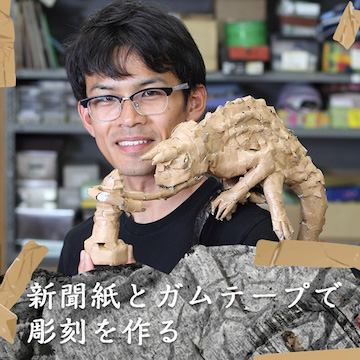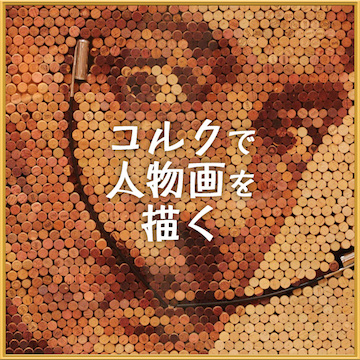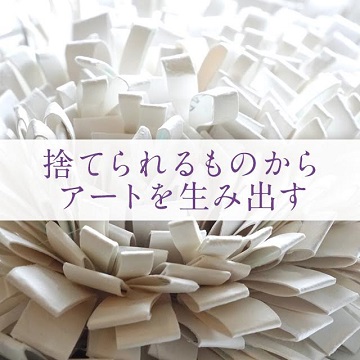Art Out of the Everyday
vol.4
Erasing to Create: Pictures into Sculptures
Irie Saya, Hiroshima prefecture
2016.10
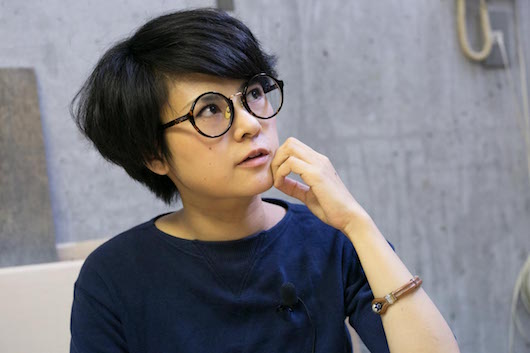
Photo: Nakasai Chiya
Creating three-dimensional figures from eraser waste or crumbles is something you could readily imagine. But erasing a picture, and then recreating the picture in three-dimensional form using the resulting eraser dust?! This is the surprising art of Irie Saya.
Making Three-Dimensional Out of Two Dimensional
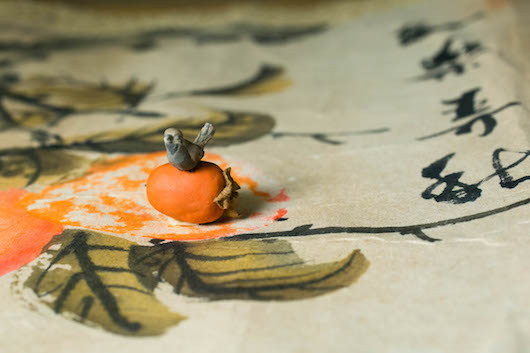
Persimmon and sparrow figure made from erasing a picture on a hanging scroll.
Photo: Nakasai Chiya
In university, I studied art, specializing in three-dimensional art. Ours being the art department, there were a lot of people majoring in drawing and painting in two-dimensional art. When it came time to work on my graduation project, I wanted to somehow combine two-dimensional and three-dimensional art. It all began with the idea of trying to make something three-dimensional out of a painting.
I first tried crushing paper to form into shapes and unraveling the fabric of a towel to create a figure, and this towel process is actually quite similar to eraser-dust art. If there was a picture of a tiger printed on the towel, I would unravel the towel and bunch up the thread to create a tiger figure. That worked out fairly well, but then I thought I'd try to do the same thing in another medium.
One day I tried erasing the picture on a newspaper advertisement, and found that when I erased a blue part of the picture, the residue from the eraser was blue. Maybe I could use that blue dust as clay to make a figure...and I thought I'd try to make that idea work.
Figures Appearing Out of Paper
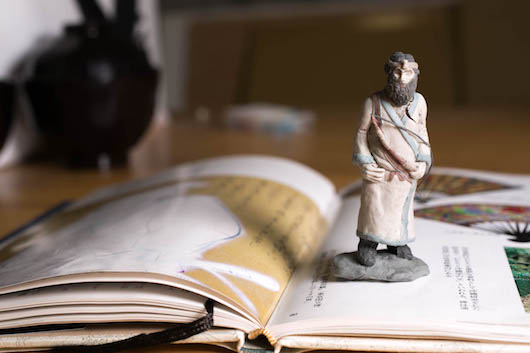
From book illustration to figurine.
Photo: Nakasai Chiya
First I tried kneading together the eraser residue from the red letters on a supermarket flyer, and then gradually began expanding the scope of my material from there. The first real artwork I made was my graduation project.
That project was a figure made from the picture on a bank note. With the crumbs from erasing the portrait on the bill as clay, I created a figure of the person portrayed there. I didn't add any color to the figure. I chose a bank note for the impact it would have on the viewer. I thought about what would really surprise people when I erased it. No one ever thinks that the picture on a piece of currency could vanish, right? Then, after erasing the portrait on a currency bill, which eliminates its value as money, the figure created acquires value as a work of art. So the concept is the conversion of something with value to something with a different value.
When the work appeared in the exhibition, someone from the Bank of Japan came and checked to see whether it was illegal in some way. I was really relieved to find out that it wasn't illegal!
Expression of the Continuity of Life Through the Ages
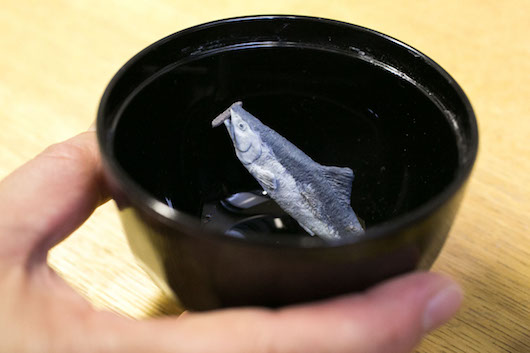
Figure of a salmon created from an advertising picture of a salmon, placed in a lacquer soup bowl.
Photo: Nakasai Chiya
After graduating from university, I went on to graduate school and changed my major to modern art. As an undergraduate specializing in 3D, I had been doing design of household goods, but more than making designs for merchandise, I felt I wanted to sell works based on more solid design concepts. In this I was influenced by the American sculptor Tom Friedman, who carved a human figure from an aspirin tablet and made a perfectly real-looking fly from human hair. He was just using materials from right around him.
In graduate school I carved dinosaur shapes into the heel or sole of shoes and figure of cows from bars of "Cow Brand" soap. Why dinosaurs? Well, the heels and soles of shoes are made from fossil fuel materials, and I wanted to carve the creature that must have come before even fossil fuels were formed. For the cows, one of the ingredients of soap is beef tallow, so I put it back into the shape of the original cows. The idea is to express the continuity of life. Life in the age of the dinosaurs may have disappeared into the distant past, but it actually is part of our lives today, in a different form.
Who Judges Value
I didn't make these erase-recreate works while I was in graduate school, but went back to it after I received my degree. I made the figure of the bodhisattva Kannon erased from a hanging scroll as an image of a deity that has appeared in this world.
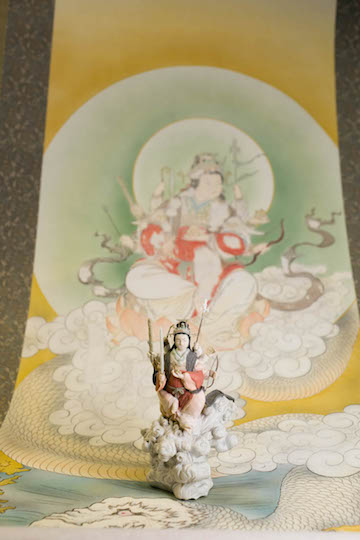
The bodhisattva Kannon (Skt. Avalokiteshvara) painted on a hanging scroll became a three-dimensional figure. This work is made with 20 erasers. Including the time for finding a suitable scroll, the work took about half a year to make.
Photo: Nakasai Chiya
Creating a work with an eraser also involves destroying something of value. Whether it is a piece of paper money, a costly hanging scroll depicting a deity, or supermarket sales flier, the surface is defaced; if the resulting dust or residue is made into a three-dimensional figure, I see figures thus created as standing on the same footing. That is part of the concept of a work of eraser-residue art.
By making a work of art by erasing and creating, sometimes something that had no more value than 10 yen ends up acquiring a value of ¥1,000,000. One can thus bring about a transformation of value. When that happens, the question arises who judges the value of things.
For Irie Saya's works, see the following sites:
http://matome.naver.jp/odai/2136941142851635501/2136941495752335003
http://iriesaya.com/web/ntm1.html
http://iriesaya.com/web/pnd2.html
Art from Things Around Me
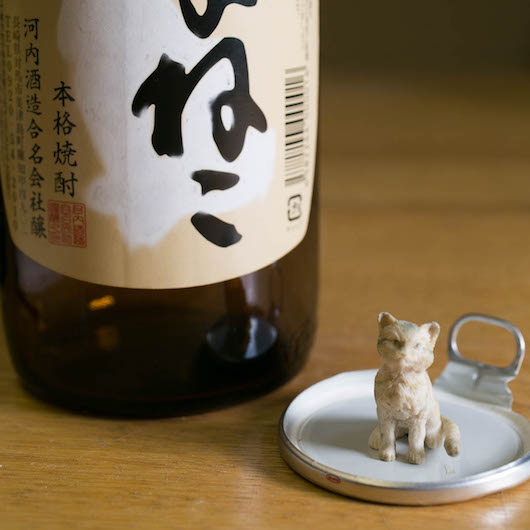
This work of a wild cat was made for an exhibition that would be held in Tsushima, Nagasaki prefecture. The wild cat picture was part of the label on a bottle of a Tsushima brand of shochu liquor. The work comes out about one quarter the size of the original image.
Photo: Nakasai Chiya
Most of my works come from things that I find right near me. What fascinates me is how something that has been a regular part of my life can change its form. Since I'm trying to make it seem as if the figure has kind of come alive out of the two-dimensional image, I imitate the picture as closely as possible. I've erased all sorts of things--the persimmon and bird from a hanging scroll, the wild cat from the shochu bottle label, figures from stamps, illustrations from books, and so on. The most difficult parts to replicate are the human faces.
The biggest figure I've made so far is the bodhisattva Kannon, the smallest is a person depicted on a stamp. The latter took about a week. It's also a challenge to make the back side of a figure, which is not visible in the two-dimensional picture.
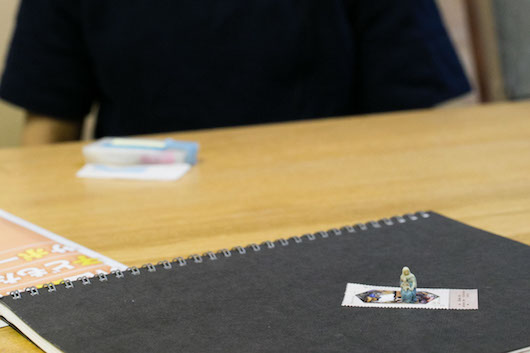
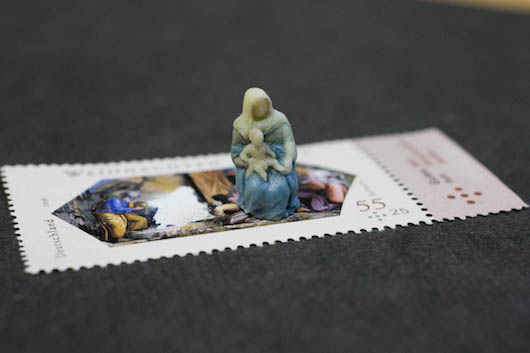
Photo: Nakasai Chiya
Selling My Works
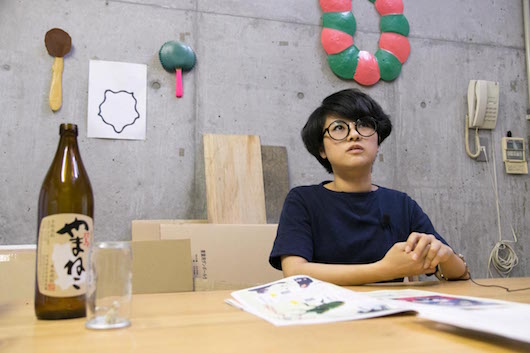
Photo: Nakasai Chiya
My graduation work made from a bank note drew a lot of attention, but it did not make much difference in my career. What really opened up opportunities for me as an artist was when I was selected to exhibit my work at Shiseido Art Egg.* I sold my first work at the solo exhibit I mounted for that event, and it got me started as an artist.
Moreover, it was people who saw my work at that exhibit who invited me to hold a solo exhibit in England and later led to another solo exhibit in Singapore, so it was a big step. In London, in addition to showing the works I had already made, I showed three-dimensional works made by erasing images from British pound notes. People were quite astonished at the small size and intricate detail of the works.
In 2016, exchange exhibits were held in the Korean city of Pusan and the Japanese city of Tsushima and I exhibited works I had made in Korea at the Tsushima exhibit. I also held an exhibit in Singapore from April to July. It was really excited to have so many people see my works. And of course the greatest satisfaction I got was when I was able to sell a work.
*The Shiseido Gallery in Tokyo's Ginza annually invites submissions for Shiseido Art Egg, a chance for upcoming artists to exhibit their work
Future Goals
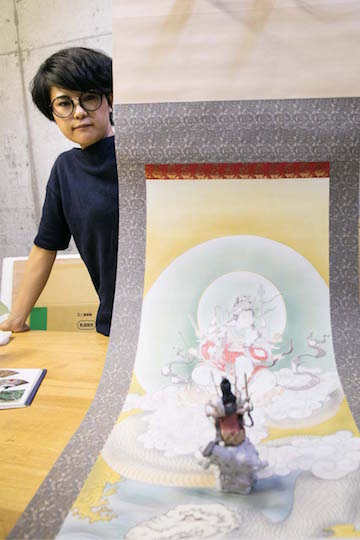
Photo: Nakasai Chiya
My idea is still a bit vague, but I hope to produce a video work. I also want to make something with the origami cranes that are presented at the Peace Park in Hiroshima. After the earthquake and tsunami disaster in Tohoku in 2011, I exhibited the akabeko (the "red cow" that is a traditional folk craft of Fukushima) with folded cranes (symbols of prayer for everlasting peace) attached like armor on their sides. The idea of this was arming ourselves with prayer. I'd like to make something larger that could be put on like regular armor.
Sets of a thousand cranes are sent to the Hiroshima Peace Memorial Museum in great number, and what to do with them is always a problem. Recently a number of stationery goods and small items that have been made by recycling the paper used in the cranes are being sold. I'd like to make an art work with the cranes, and it, too, would be based on the recycling concept.
How to Make Eraser-Residue Art
1.Buy two kinds of erasers. One should be an ordinary eraser such as you can get anywhere. The other should be made with non-petroleum materials and say "Non-PVC" on the label. Using these two kinds together makes a malleable eraser "clay." Irie says, "this is what worked for me by happenstance using the erasers I had around."
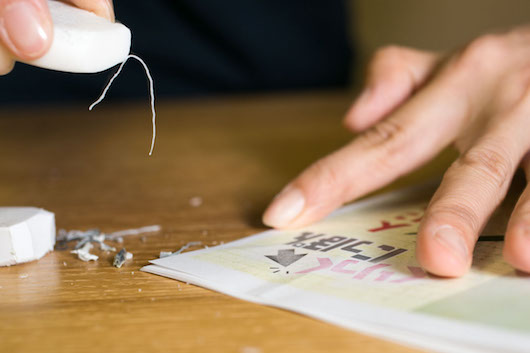
2. Some materials are easier to erase than others. If a hanging scroll is made of fabric, the color won't erase. On paper, printing done by a laser printer is easier to erase than that done by ink-jet printers. Depending on the source material, it may take longer to erase the picture than to make the figure.
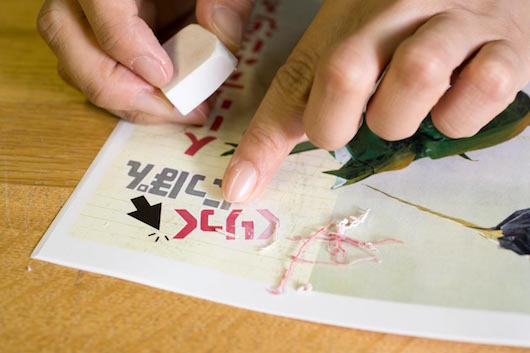
3. If you knead the eraser clay with your hands, the color will darken, so it is best to use a small pestle such as used in cooking. When shaping and trimming the material as well, it is best to avoid touching it directly with the fingers.
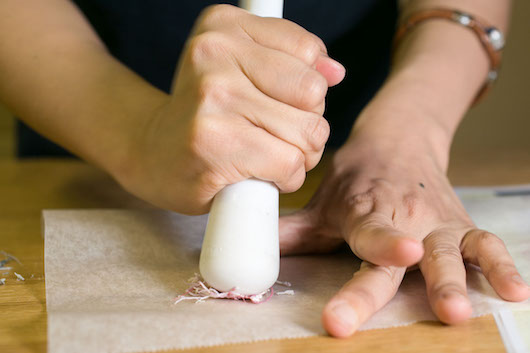
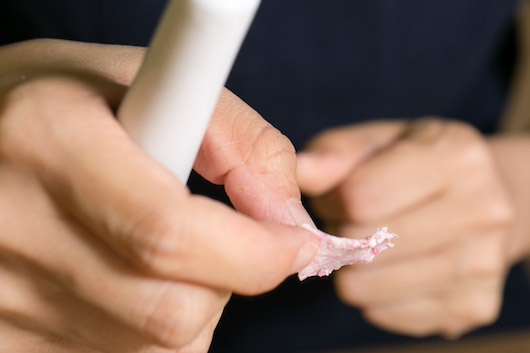
4. To shape the eraser clay, use a cutter knife, crochet hook, needle, toothpicks, and other such tools.
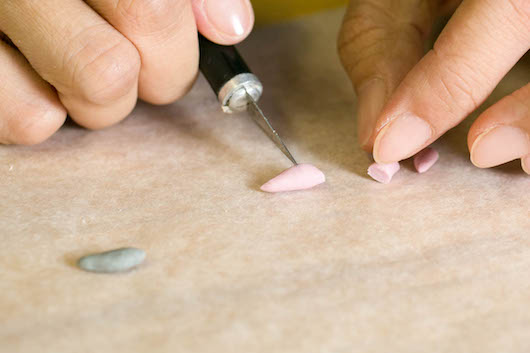
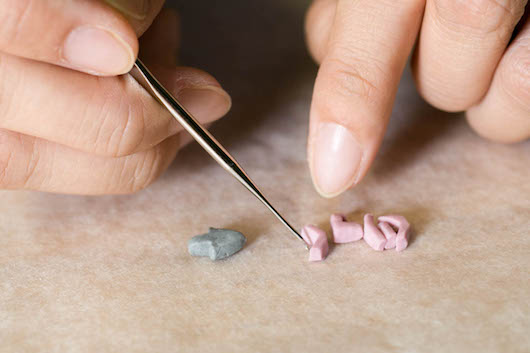
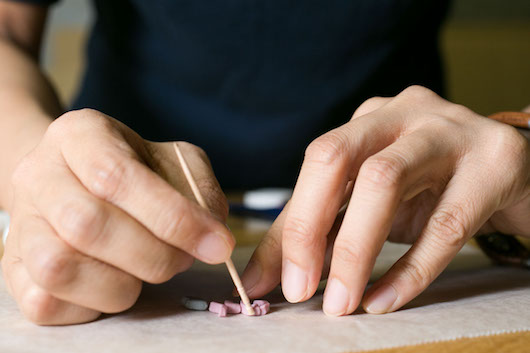
5. The completed work sample.
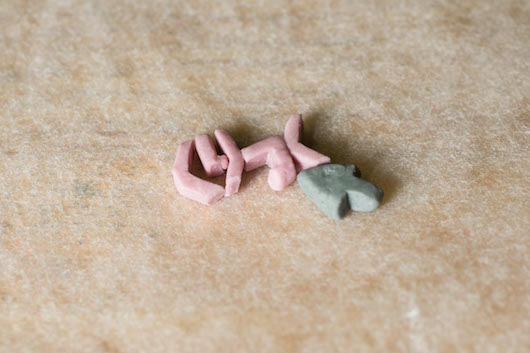
Photo: Nakasai Chiya










